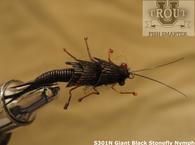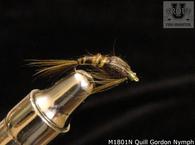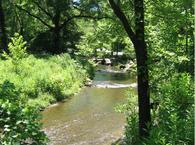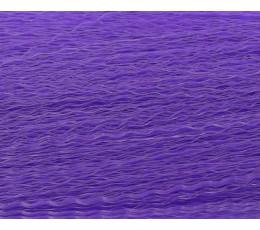This course describes the various types of equipment most commonly used for trout fishing. Fly reels, spincast reels and spinner reels will be discussed in detail. Also, the unique use of cane poles will be included in the discussion.
Cane Poles: This is a simple pole made from bamboo canes, and fished without a reel. Typically, they are about 12’-14’ feet long, and they come in 2 or 3 sections. Usually, you would use approximately 6’-10’ of light (2-4lb test) line with a dry fly attached to the end. Cane Poles were used by the early pioneers when Tennessee was the West. This tackle is best suited for small streams with large boulders/steep descent which allows you to hide from the fish and still closely approach them. The lure of choice for this pole is a dry fly to imitate terrestrials or adult mayflies. When fishing with a cane pole, approach the stream with stealth, moving upstream. You may, or not, see a trout feeding in the current. Then dangle the fly about 1 or 2 inches above the surface, moving the fly in a figure eight loop. The trout will find this approach irresistible and will jump out of the water trying to catch the fly. Often times, the trout will circle the fly in ever faster circles prior to jumping for the tasty morsel. However, if the trout misses on the first try, keep the figure eight movement. I f you can see the trout, place it directly above the head and slightly ahead of the trout. This is a most interesting and often rewarding method of fishing, since you see the trout jumping.
Spincast Reel: – This is the type of reel most people learn to fish with as a child. Most of these reels currently being made are not durable, and will not last long. However, they are generally the easiest to use. To cast, press and hold down the button. Release the button when you want the line to begin going out which is usually at the top of the stroke. Typically, you would use 4-8lb test line on the spool and use this type of reel for live bait, in-line spinners, and lures, such as those imitating minnows. Additionally, the drag must be set properly to be sure line will come off the reel without breaking, if a large fish bites. Approach the stream working upstream, and cast as far into the pool as possible trying to land the lure in the foam at the head of the pool. Then, crank in the lure experimenting with different speeds of retrieve. Also, the lure can be bumped along the bottom which will attract fish as well.
Spinning Reel: – The Spinning Reel, also known as the Open Faced Reel, is probably the most common type of reel used for trout fishing, other than perhaps a fly reel. A spinning reel represents the best compromise between ease of use, durability, and ability to cast small lures on light line. On this type of reel, there is a bail that revolves around a stationary, central spool, to wrap the line on the spool as the handle is turned. This bail must be rotated out of the way during casting, to allow the line to go out. This reel would typically be used in similar situations as the spincast reel. Often in trout fishing, a small spinning reel is coupled with an ultralight spinning rod for casting light lures and line, while providing good action even when catching small fish. Typically, the handle on this type of reel can be reversed to accommodate either right or left-handed fishers. (This should be confirmed, however, prior to purchasing a reel.) Additionally, the drag must be set properly to be sure line will come off the reel without breaking, if a large fish bites. The technique for using this reel is the same technique used with the Spincast Reel. More
Fly Rod: – Fly fishing is unique in that it typically relies on the weight of the fly line to pull the fly through the air. (Other types of tackle rely on the weight of the lure pulling out the line.) Flies are light weight; often hand tied, and are intended to mimic the insects most often found in trout streams. These flies are the lures being propelled by the line. Fly rods are typically 7’-9’ long, though there are some smaller ones being used (typically on small, overgrown streams). We recommend a relatively long rod (8’-9’ long) for the following reasons:
1 It keeps more of the fly line out of the water while fishing, reducing drag on the fly.
2. It allows longer casts on larger streams.
3. It makes fly retrieval a little easier when the fly is caught in the stream or in the brush.
4. It allows greater range with the caning and slingshot techniques. The action of the fly rod and weight of the fly line should be matched to provide the best action, depending on the sizes of the fish and stream you are fishing.
The fly reel:- The reel, used with the fly rod, is relatively simple, in that it simply holds the line while not being used. (I.e. There is no casting feature required.) The line is pulled out by hand as it is needed for longer casts. Typically, these reels can be reversed to accommodate either left or right handed fishers. Additionally, the drag must be set properly to be sure line will come off the reel without breaking, if a large fish bites.
The fly line: - It can either be floating (this is the most common, and can often be used for all types of flies in shallow streams), or sinking (this would be used primarily for nymphs and streamers in deep streams). Additionally, the taper of the fly line determines how far/gently it casts. The beginner will likely want to use a double tapered line, which allows good casting distance, with a gentler landing as the line hits the water. Because of the size/visibility of the fly line, a monofilament leader is typically used on the end of the fly line. This leader is tapered (either as a continuous taper, or as individual pieces of monofilament, decreasing is size, tied end to end.) to prevent it from becoming knotted while casting. As the end of the leader becomes shorter (either by breakage or by repeatedly cutting off and tying on flies), a small piece of monofilament (called tippet material) is tied on, to preserve the overall length of the leader. We recommend using an overall length of leader roughly equal to the length of the rod. When using fly line in a stream, try to keep as much of the line out of the water as possible, to avoid the effects of drag on the line. For example, if your fly lands in still water, and your fly line lands in fast water, the line will be moving faster than the fly to the extent that it will eventually pull the fly through the still water. Finally, don’t overlook small “tidal pools”, pocket water (non-pooling water), downed trees, and crevices under rocks as hiding places for trout (especially brown trout).

Hook Sizes, Patterns and Parts
In the illustration above, the various parts of the hook are shown with their proper names.
Broken Rods This is a must before you take your first trip!
Study these basic FLIES
Review this BLOG
Take a tour of the TroutU University Store and check out the equipment.
Fly Line Facts is an indepth look at fly lines.
Read these instructional DVD's to further your fly fishing knowledge.
Getting Started Fly Fishing Basics Contains basic information to help you select optimal equipment.
Top 85 Tips on Fly Fishing for Trout Contains valuable information to help you get started in catching more trout.
Trout and Their Habitat Learn about the habits and the locations of the various trout species.





